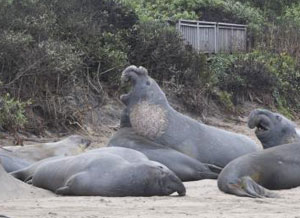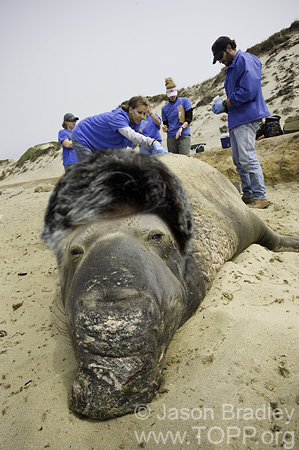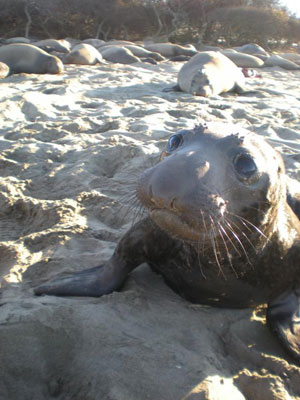Want to know the truthiness about northern elephant seals? Become a Facebook friend of Stelephant Colbert.
Stelephant and his prime-time rival, Jon Sealwart, are a couple of funny guys who are showing off for the ladies, trading barbs, and mugging for the camera.
But we're not talking fake news here. Stelephant and Jon are elephant seals who've hauled their blubbery masses onto the sand for the elephant seal love-in and birth-fest that happens every year at Año Nuevo State Natural Reserve, about 21 miles north of Santa Cruz.
And we landlubbers can follow their antics, travels, adventures, and (oh my) love affairs by reading blogs written by researchers at UC Santa Cruz who are studying the animals and making progress in the quest to understand their behavior, migration, physiology, and more.
"As a patriotic Pinniped-American, it is my sworn duty to consume as much as possible whenever possible, and to horde women like real estate to broadcast my social status as brilliant and clear as the chrome on Kanye's rims," blusters Stelephant's blog in a dead-on impression of the human Colbert, replete with Jon Sealwart put-downs.
"Stelephant is getting 15 friends a day at least," said Nicole Teutschel, a graduate student in the Ecology and Evolutionary Biology Department at UCSC who also coordinates education and outreach for social media for the seal component of Tagging of Pacific Predators (TOPP). As of Thursday, Stelephant had 262 friends.
Naming two seals after fake-news-show titans Stephen Colbert of the Colbert Report and Jon Stewart of the Daily Show was, Teutschel admits, a naked (and big, floppy-nosed) attempt to appeal to Colbert's obsession with being "name-afterable" and perhaps get mentioned on those shows, much the way Stephanie Colburtle the Turtle was in 2007.
Stephanie Colburtle is described on Colbert's Wikipedia spoof Wikiality as "Stephen's beautiful adopted sea turtle daughter." The student researchers at Drexel University in Philadelphia named Stephanie after Colbert as part of their research into tracking turtle migrations to the Galapagos Islands. She participated the Great Turtle Race, which Colbert featured on his show.
However, Stelephant and Jon aren't the only Año Nuevo seals who got names this year. There are also males Monty, Nat, and Sebastian, and females Josephine, Sunny, Bottleneck, Featherfoot, Sandie, Ellie, Poppy, Callie, Sidda, and Spot.
Many of those names came from students who are following the seals at Valencia Elementary School in Aptos and Hillbrook Elementary School in Los Gatos.
These seals are also befriendable--and make for great reading--on Facebook (or, for the Facebook-phobic, you can also find their blogs and track their progress on the TOPP website). Their blogs are, however, much tamer than those of the in-your-face Stelephant Colbert and Jon Sealwart. With a little fancy first-person writing and some help from Photoshop, the TOPP team has had a good time impersonating (im-seal-ating?) the real Colbert and Stewart.
The other seals' blogs are from the researchers' point of view and focus on such topics as tag removal and pup births. They're also packed with photos of big fat seals and adorable seal pups lounging on the beach.
However, even Stelephant's and Jon's blogs will soon introduce more scientific topics such as alpha males and reproduction, said Teutschel.
This is the second year TOPP has named seals. Naming the seals and tracking them through blogs is part of Elephant Seal Homecoming Days, a program sponsored by TOPP and California State Parks. Several thousand elephant seals return each winter from the far reaches of the North Pacific Ocean to molt, mate, and give birth to their pups on the beaches of Año Nuevo. To celebrate the migration, TOPP wanted to invite the community to witness and learn about the seals' annual journey.
The tracking of these seals began when researchers from ecology and evolutionary biology professor Dan Costa's lab at Long Marine Lab attached high-tech satellite tags to 30 elephant seals last summer.
The tags allow researchers to learn about marine science, as well as elephant seal physiology, migration, behavior, and more. For eight months, the seals lived and foraged along the rich edges of the massive eddies that swirl across the North Pacific, swimming constantly and diving repeatedly to depths of 600-1,000 meters or more. Then they made a U-turn and traveled thousands of miles back to their harems.
Researchers assigned names to 15 of the seals and have followed them back to shore through blogs about their arrival, their pups' birth, tag removal, and other tidbits.
Naming the seals helps people connect to individual animals, said Costa.
"We don't relate well to populations and abstract concepts," Costa said. "People can relate to a pet with a name but don't have the same interaction with animals at large. So naming them makes it more personal and allows people to identify with them."
Costa sees Seal Homecoming Days and Facebook pages as "our opportunity to educate the public on what we do and why it's relevant and important," he said. "It's also important for researchers to be accountable to the public, so that the public appreciates what we do and why. Also, we are a university, and a major role of what we do is education, so this is an extension of that responsibility."
The seals are pretty impressive sitting on the beach--but that's just a small part of their story, said Costa.
"The bigger story is what they do when they're not on the beach, which is most of the year," he said. "They dive to incredible depths and go halfway across the Pacific and back."
This research is certainly fascinating and important. But what if Stephen Colbert were to find out about his namesake elephant seal and give Costa a call?
"I'm a big fan!" said Costa. "I would love to just have a discussion with him and tell him about these amazing animals. Ultimately, the more we appreciate them, the more we will want to protect them and their marine environment."
Note to reporters: You may contact Dan Costa at costa@biology.ucsc.edu and Nicole Teutschel at nicole@topp.org.





